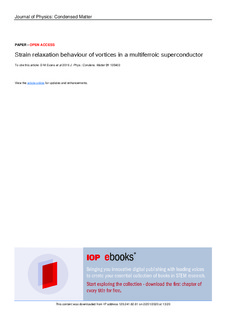| dc.contributor.author | Evans, Donald | |
| dc.contributor.author | Schiemer, J. A. | |
| dc.contributor.author | Wolf, T. | |
| dc.contributor.author | Adelmann, P. | |
| dc.contributor.author | Böhmer, A. E. | |
| dc.contributor.author | Meingast, C. | |
| dc.contributor.author | Dutton, S. E. | |
| dc.contributor.author | Mukherjee, P. | |
| dc.contributor.author | Hsu, Y.-T. | |
| dc.contributor.author | Carpenter, Michael A. | |
| dc.date.accessioned | 2020-02-07T13:12:38Z | |
| dc.date.available | 2020-02-07T13:12:38Z | |
| dc.date.created | 2019-02-13T11:31:50Z | |
| dc.date.issued | 2019 | |
| dc.identifier.issn | 0953-8984 | |
| dc.identifier.uri | http://hdl.handle.net/11250/2640452 | |
| dc.description.abstract | The elastic and anelastic properties of a single crystal of Co-doped pnictide Ba(Fe0.957Co0.043)2As2 have been determined by resonant ultrasound spectroscopy in the frequency range 10–500 kHz, both as a function of temperature through the normal-superconducting transition (T c ≈ 12.5 K) and as a function of applied magnetic field up to 12.5 T. Correlation with thermal expansion, electrical resistivity, heat capacity, DC and AC magnetic data from crystals taken from the same synthetic batch has revealed the permeating influence of strain on coupling between order parameters for the ferroelastic (Q E) and superconducting (Q SC) transitions and on the freezing/relaxation behaviour of vortices. Elastic softening through T c in zero field can be understood in terms of classical coupling of the order parameter with the shear strain e 6, λe 6 , which means that there must be a common strain mechanism for coupling of the form λ Q E. At fields of ~5 T and above, this softening is masked by Debye-like stiffening and acoustic loss processes due to vortex freezing. The first loss peak may be associated with the establishment of superconductivity on ferroelastic twin walls ahead of the matrix and the second is due to the vortex liquid–vortex glass transition. Strain contrast between vortex cores and the superconducting matrix will contribute significantly to interactions of vortices both with each other and with the underlying crystal structure. These interactions imply that iron-pnictides represent a class of multiferroic superconductors in which strain-mediated coupling occurs between the multiferroic properties (ferroelasticity, antiferromagnetism) and superconductivity. | nb_NO |
| dc.language.iso | eng | nb_NO |
| dc.publisher | IOP Publishing | nb_NO |
| dc.rights | Navngivelse 4.0 Internasjonal | * |
| dc.rights.uri | http://creativecommons.org/licenses/by/4.0/deed.no | * |
| dc.title | Strain relaxation behaviour of vortices in a multiferroic superconductor | nb_NO |
| dc.type | Journal article | nb_NO |
| dc.type | Peer reviewed | nb_NO |
| dc.description.version | publishedVersion | nb_NO |
| dc.source.volume | 31 | nb_NO |
| dc.source.journal | Journal of Physics: Condensed Matter | nb_NO |
| dc.identifier.doi | 10.1088/1361-648X/aafbd7 | |
| dc.identifier.cristin | 1676873 | |
| dc.description.localcode | Original content from this work may be used under the terms of the Creative Commons Attribution 3.0 licence. Any further distribution of this work must maintain attribution to the author(s) and the title of the work, journal citation and DOI. | nb_NO |
| cristin.unitcode | 194,66,35,0 | |
| cristin.unitname | Institutt for materialteknologi | |
| cristin.ispublished | true | |
| cristin.fulltext | original | |
| cristin.qualitycode | 1 | |

